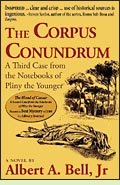|
The Corpus Conundrumby Albert A. Bell, Jr.Reviewed by Margaret Donsbach In The Corpus Conundrum, Pliny encounters the puzzling body of a man in the woods behind his seaside villa at Laurentum. His dogs whine and circle the body, refusing to go near it. Sharing his uncle's fascination with the processes of nature, Pliny examines the corpus and resolves to find out how the man died. "What puzzled me the most at the moment was the lack of dark splotches on any part of the body. During his extensive military service, my uncle had observed that, when a person dies, discolorations, almost like bruises, develop after a short time on whatever side of the body is lowest." He has his slaves move it into an empty stall in his stable and seals the door to prevent tampering. The next morning, to his consternation, the body has disappeared. Also playing roles are Pliny's mother; his irritating friend Tacitus; a pair of officious duovirs responsible for law and order in Laurentum; a beautiful whore; an ingratiating young man claiming to be the missing corpse's son; and a woman accused of being an empusa, a blood-sucking, night-wandering ghoul. Pliny is a rationalist disinclined to accept supernatural explanations, but as events grow stranger his rationalism is tested, something that would feel more credible if the novel's rather flat prose style evoked a spookier atmosphere. Regardless, something is always happening to keep the pacing brisk, and the story offers an engaging introduction to the Plinys elder and younger, both significant figures in Roman literature. (2011; 279 pages, including a Glossary and an English translation of a letter by Pliny describing his villa at Laurentum) More about The Corpus Conundrum at Powell's Books or Amazon.com
All Roads Lead to Murder by Albert A. Bell, Jr. (2002), #1 in the Pliny the Younger mystery series. More info Roman Blood by Steven Saylor (1991), #1 in the Roma Sub Rosa mystery series about an unofficial "finder" who investigates cases of murder in ancient Rome. More info The Silver Pigs by Lindsey Davis (1989), #1 in the Falco mystery series about a Roman informer who looks into cases of murder and other serious crimes. More info
Pliny the Younger: Complete Letters (2006 Oxford University Press edition). More info Ashen Sky: The Letters of Pliny the Younger on the Eruption of Vesuvius by Pliny the Younger (2007 Getty Museum edition, illustrated by Barry Moser). More info Pliny's Encyclopedia: The Reception of the Natural History by Aude Doody (2010), about Pliny the Elder's Natural History. More info
Pliny the Elder, The Natural History, a complete, searchable English translation by John Bostock and H.T. Riley, at the Perseus website Back to Novels of Ancient History
|
